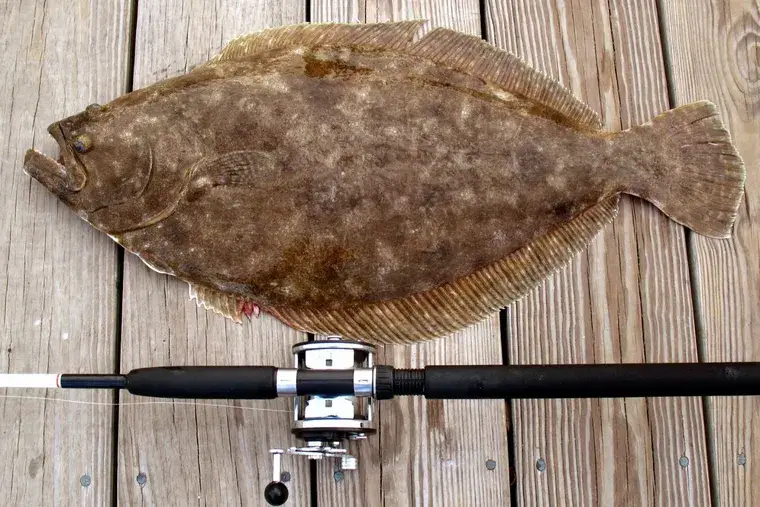Both flukes and flounders are bottom-dwelling flatfish found in the Atlantic Ocean that lies low on the bed of the ocean and can blend with their environment. Both flounder and fluke are prized for taste and are very available on the entire Atlantic coast and back-bay waters but are extremely similar in appearance. What’s the difference between fluke and flounder?
Flounder(Winter Flounder) have eyes on the right side
smaller in size
darker-reddish/olive green color
smaller mouth & flatter teeth
Fluke (Summer Flounder) have eyes on the left side of their body
much lighter/brown color
have three-ringed, eye-like spots on their back & tail
bigger mouth & sharper teeth
Winter flounder and Summer flounder (fluke) have a few distinct differences, but most anglers and fish lovers agree both fish make for great eating. Both are easier to catch and they are a blast for people like you and me, who love fishing as an activity or just getting out onto the saltwater for the day.
Introduction:
When staring down the seafood aisle, many consumers find themselves in a floundering confusion over the differences between various fish types, notably Fluke and Flounder. While both come from the same flatfish family and share a similar appearance, they are distinctly different species with unique characteristics. This article will dive into the great Fluke vs Flounder debate, offering valuable insights into both kinds of fish, their environments, diets, and culinary uses to provide a better understanding and help consumers make an informed choice for their next seafood feast.
Fluke vs Flounder
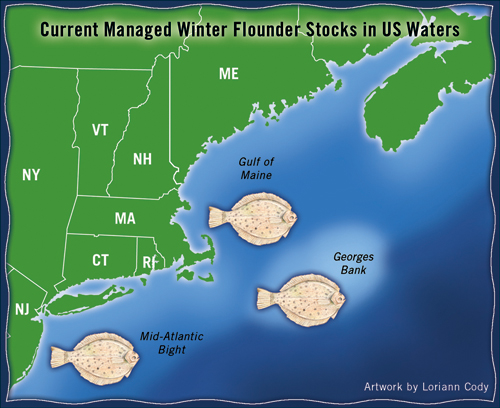
Flounder fish belong to a group of fish, specifically flatfish, that encompass different species and families, though they all belong to the order (Pleuronectiformes)
These fish live on the bottom of the ocean, where they lie and wait for dinner on their wide, flat bodies, and have both eyes on one side of their heads either the left or right, depending on the species Summer flounder has eyes on the left and Winter flounder on the right.
Flounder’s eyes start like any normal fish with one eye on each side of its head but as it matures its eyes will migrate to one side or the other moving towards the top of its head. The summer flounder species is one of the most popular recreational fish on the Atlantic coast.
Depending on their size, females have between 460,000 and more than 4 million eggs. They release the eggs into the water column and the eggs hatch in the waters of the continental shelf.
Flounders are medium-sized fish, that can weigh from 5 up to 30 pounds, from pinkish to snow-white in color. Found all over the world and there are around 540 species.
Flounder fish are found in Northern waters and are caught all along the Northern East Atlantic Coast of the United States from Florida to Nova Scotia. Some species have spots or rings on their back and can be distinguished because at least five of these dark spots are arranged in an “X” pattern.
Winter Flounder
Winter flounder, also known as blackback flounder, has a distinctive appearance. Here are some key characteristics:
-
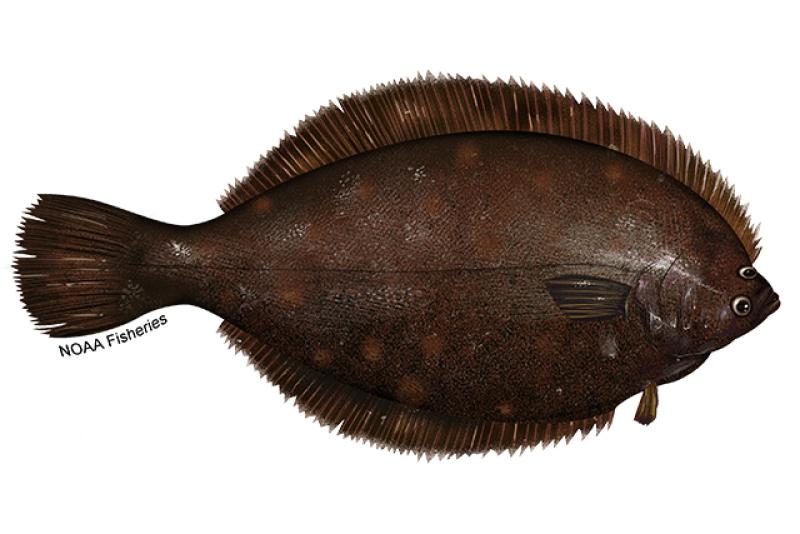
Winter Flounder | NOAA Fisheries Coloration: Winter flounder typically have a mottled brown or olive-green coloration on their upper side, which helps them blend in with the sandy or muddy bottoms where they live. Their underside is usually white.
-
Body Shape: They have a flat, oval-shaped body with both eyes on the upper side. Their body is adapted for life on the ocean floor, allowing them to camouflage themselves against predators and prey.
-
Size: Winter flounder are generally smaller compared to other flounder species, with adults typically ranging from 12 to 18 inches in length, although some individuals can grow larger.
-
Fins: They have dorsal and anal fins that extend around their body, giving them a somewhat circular shape when viewed from above. Their caudal fin (tail fin) is rounded.
-
Eyes: Their eyes are set on the same side of their body, which is characteristic of all flounder species. This adaptation allows them to lie flat on the ocean floor and ambush prey effectively.
-
Mouth: Their mouth is relatively small and downturned, suited for feeding on bottom-dwelling organisms such as crustaceans, mollusks, and small fish.
Overall, winter flounder have a unique appearance that helps them thrive in their habitat along the sandy and muddy bottoms of coastal waters.
- Anglers fish for Winter flounder from the shore, piers, and boats with hook-and-line gear.
- The recreational harvest limits for each state are based on the recreational catch in 1998.
- Regulations for the recreational fishery are typically adjusted annually. They include an annual harvest limit, closed seasons, a minimum size for landed fish, and possession limits.
Their bodies are flat with both eyes on one side. They spend their lives on the ocean’s floor camouflaging themselves against the sand or rock bottom. Flounders can even change the color of their skin to better disguise themselves on the ocean floor. They are a beloved and popular food fish. Flounder has a very mild flavor and flaky white flesh and is known for its great taste.
Baitfish make up the majority of a flounder’s diet. If you’re fishing in the right area and the right type of water, without seeing at least some schools of baitfish swimming around. Finger mullet bloodworms, and other small baitfish like croaker, mud minnows, or menhaden. These baits are normally readily available and widely consumed by flounders.
Winter flounder are different from the other flounder species with eyes on the right side of their body and living in colder waters further north. This flounder also grows slightly larger averaging between three and eight pounds. The winter flounder can be found as far south as North Carolina but their typical range is from Deleware Bay to the Gulf of St. Lawrence in Canada.
It’s rare to find documented cases that report deaths from an Electric Eel’s shock, but it can happen. An adult eel can produce a lethal 600 volts of electrical energy, which could cause a person to stop breathing, go into heart failure, or incapacitate them long enough to cause him or her to drown …………………………………………………………………. Read more
Fluke Fish(Summer Flounder)
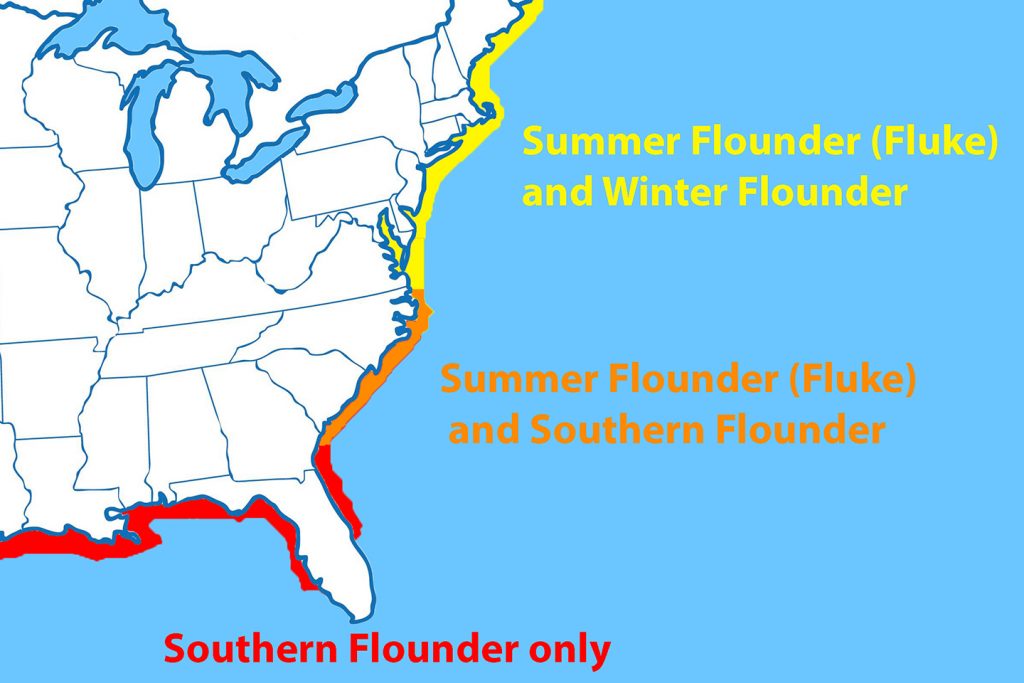
Fluke(Summer Flounder) The scientific name for fluke fish is Paralichthys dentatus. They’re mostly more often called by their well-known name Summer flounder but on the United States East Coast they’re most commonly referred to as ‘fluke.’
This order is commonly grouped into what’s called ‘flatfishes, which are large-tooth flounders and contain approximately 110 species.
Fluke is generally bigger and toothier than the Winter Flounder, but Fluke is a Flounder. Fluke is another name for Summer Flounder, a large, predatory species of Flatfish that lives in the North Atlantic. The reason people get confused is that Winter Flounder also lives in the same place. Luckily, there are some ways to tell these guys apart.
Like other flatfish species of fish, they have flat bodies that remain near the ideal floor and have colorings that match the sea bottom.
The Fluke fish species can also adjust their color to better match their surroundings and blend into their environment. Flukes also have spots on their back that can be an important feature that can help distinguish the species.
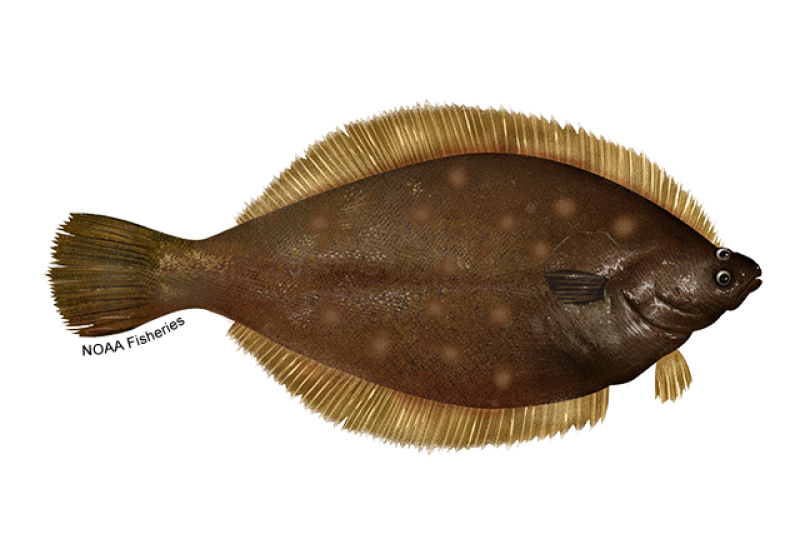
During colder months fluke fish will move offshore to depths of up to 600 feet. During the spring and summer, fluke fish move into feeding grounds closer to shore that are also shared by smaller fish. As Fluke gets older they will commonly migrate and move into northerly shallower feeding grounds.
Fluke is generally bigger and toothier than Winter Flounder, Fluke is Flounder. Fluke is another name for Summer Flounder, a large, predatory species of Flatfish that lives in the North Atlantic. The reason people get confused is that Winter Flounder also lives in the same place. Luckily, there are some easy ways to tell the two apart.
Summer flounders have three-ringed, eye-like spots on their body. Near their tail, and several more on their back. The spots on their body are arranged in an “X” pattern.
Fluke Diet
- Larval and post-larval flounder feed on zooplankton and small crustaceans.
- Juveniles eat crustaceans and fish.
- Adults are opportunistic feeders, eating whatever food is convenient at the time, and feed mostly on fish and crustaceans.
Southern Flounder

The Southern flounder, a fascinating denizen of coastal waters, boasts a distinct appearance perfectly suited to its environment. With a flattened, oval-shaped body, this species seamlessly blends into the sandy or muddy bottoms where it resides.
Sporting a mottled brown or olive-green hue on its upper side and a contrasting white underside, the Southern flounder’s coloration serves as camouflage against potential predators and prey alike. Its eyes, both situated on the left side of its body, allow for effective ambush hunting, as it lies in wait, hidden from view.
Dorsal and anal fins extend around its body, contributing to its rounded silhouette when viewed from above, while a large, upward-facing mouth accommodates a diverse diet of fish, crustaceans, and mollusks. Ranging from 12 to 25 inches in length, with some individuals growing even larger, the Southern flounder embodies both the grace and adaptability necessary for survival in the dynamic coastal ecosystems it calls home.
Southern flounder, like other flounder species, have distinct characteristics that make them well-adapted to their habitat. Here’s what they typically look like:
- Coloration: Southern flounder often have a mottled brown or olive-green coloration on their upper side, similar to other flounder species. Their coloration helps them blend in with the sandy or muddy bottoms where they live. The underside of the Southern flounder is usually white.
- Body Shape: Southern flounder have a flat, oval-shaped body, characteristic of flounder species. Their body is flattened laterally, allowing them to rest on the ocean floor with both eyes facing upward.
- Size: Southern flounder can vary in size, but adults typically range from 12 to 25 inches in length. Some individuals may grow even larger.
- Fins: They have dorsal and anal fins that extend around their body, giving them a somewhat circular shape when viewed from above. Their caudal fin (tail fin) is rounded.
- Eyes: Both of their eyes are located on the left side of their body. This adaptation allows them to lie camouflaged on the ocean floor and ambush prey effectively.
- Mouth: Their mouth is relatively large and upward-facing, allowing them to consume a variety of prey including fish, crustaceans, and mollusks.
- Skin Texture: The skin of Southern flounder is usually smooth, with small scales covering their body.
Overall, Southern flounder share many similarities in appearance with other flounder species, but their specific coloration and size may vary slightly depending on their habitat and geographic location.
Fish scales act like armor protecting fish from scrapes on rocks & branches protecting the fish from injury, & shielding fish from predators. Scales provide defense against parasites. They make fish more aerodynamic & help them move through the water faster up, down, or sideways without changing speed ……………………………………………………………… Read more
Key Differences Between Summer Flounder and Winter Flounder

Summer flounders or (Fluke) prefer to spawn in deeper waters at sea in the fall and winter. They have eyes on the left side of the head. Summer flounder grows fast in their relatively short life of about 12 to 14 years. Males of the species can grow to be more than 2 feet in length, while females get up to 3 feet.
These flounders migrate in the summer or spring, leaving the deep ocean waters to move inshore along beaches, inlets, bays, estuaries, canals, and creeks. They normally grow to a maximum weight of about 15 pounds, although larger fish have occasionally been reported.
The average size of Summer flounder, when caught, is between 2 to 5 pounds. Summer flounders have bigger mouths and sharp teeth that are pronounced.
Winter flounders can grow to be more than 2 feet in length at the ages of 15 to 18 years that they live but their average weight is similar to summer flounders. Winter flounders enjoy colder water and will enter shallow bays and coves in winter and spring to spawn and live until the seasonal sun warms the water above their preferred temperature.
Winter flounder are different from the other flounder species with eyes on the right side of their body and living in colder waters further north. This flounder also grows slightly larger averaging between three and eight pounds.
The Winter flounder can be found as far south as North Carolina but their typical range is from Delaware Bay to the Gulf of St. Lawrence in Canada.
This species of flounder spawns during the winter and fall seasons in shallow, inshore waters and bays. This flounder has a smaller mouth and flatter teeth than its Summer cousin. They are normally darker with a reddish-brown and olive-green hue that can match their surrounding environment.
Summer flounder (Paralichthys dentatus) and Winter flounder (Pseudopleuronectes americanus) are two distinct species of flatfish found in North American waters. Here are some key differences between them:
-
Habitat:
- Summer Flounder: They are typically found in warmer waters along the Atlantic coast of North America, ranging from the Gulf of Mexico to the Gulf of Maine. They inhabit sandy or muddy bottoms and can be found in both shallow and deeper waters.
- Winter Flounder: These flounder are found in colder waters along the Atlantic coast, ranging from North Carolina to Newfoundland. They prefer shallower waters and are often found in estuaries, bays, and coastal areas.
-
Coloration:
- Summer Flounder: They are usually brown or olive with a mottled pattern that helps them blend in with the sandy or muddy ocean floor. They can change their color to some extent to match their surroundings.
- Winter Flounder: They have a lighter coloration, ranging from light brown to olive, with a more pronounced mottled pattern. This coloration helps them camouflage in their specific habitats.
-
Body Shape:
- Summer Flounder: Their body is more elongated and laterally compressed, which allows them to lie flat on the ocean floor. Both of their eyes are on the upper side of the body.
- Winter Flounder: They have a rounder body shape and are less laterally compressed compared to summer flounder. Their eyes are also on the upper side of the body.
-
Size:
- Summer Flounder: They can grow larger than winter flounder, with some individuals reaching lengths of over 30 inches.
- Winter Flounder: Generally, they are smaller than summer flounder, with most individuals ranging from 12 to 18 inches in length.
-
Feeding Habits:
- Summer Flounder: They are opportunistic predators, feeding on a variety of fish and invertebrates, including squid, shrimp, and small fish.
- Winter Flounder: Their diet consists mainly of small invertebrates, crustaceans, and worms that are found in the sediment.
Understanding these differences can help in identifying and distinguishing between summer flounder and winter flounder in their natural habitats.
Flounder Fishing Size limit (New Jersey)
As of my last update in January 2023, the summer flounder (fluke) size limit for recreational fishing in New Jersey was 18 inches. Keep in mind that fishing regulations can change, so it’s essential to check the most recent updates from the New Jersey Division of Fish and Wildlife or other relevant authorities for the current size limit before planning any fishing activities. Additionally, regulations may vary for different seasons and areas, so be sure to review all relevant guidelines.
New Jersey Fluke (Summer Flounder)
Regulations for the recreational fishery are typically adjusted annually. They include an annual harvest limit, closed seasons, a minimum size for landed fish, and possession limits. Recreational landings varied widely over the years until harvest limits were put in place in 1993.
Summer Flounder in New Jersey was just adjusted as it is every now and again and will be getting a longer season in 2022. Fluke fishing will be open on May 2 and close on September 27. The longer season will provide more opportunities for backwater fluke fishermen, particularly in the southern part of the state.
The limits themselves are somewhat more complicated. By 2022, fishermen will be allowed to take two flukes between 17 and 17.99 inches, and one fluke over 18 inches. This is different from 2021’s regulations when fishermen were allowed to keep 3 flukes over 18 inches.
This was one of five of the regulations proposed, four of which were aimed at an increase in the fluke harvest between 15.9% and 16.5% over last year. With the longer season and the ability to keep two fish in a smaller size slot, it’s estimated that the new regulations will provide a 16.5% increase in fluke harvest. from On The Water April 2022
New Jersey’s Winter Flounder season runs from:
- March 1 through December 31
- with a two-fish bag limit and
- 12-inch minimum size
Check your state’s Regulation for Fishing before you go out!
Conclusion:
Both flukes and flounders are bottom-dwelling flatfish found in the Atlantic Ocean that lie low on the bed of the ocean and can blend with their environment. Both flounder and fluke are prized for taste and are very available on the entire Atlantic coast and back-bay waters but are extremely similar in appearance. With very few differences between them.
Flounder(Winter Flounder)
have eyes on the right side
smaller in size
darker- reddish/olive green color
smaller mouth & flatter teeth
Fluke (Summer Flounder)
have eyes on the left side of their body
much lighter/brown color
have three-ringed, eye-like spots on their back & tail
bigger mouth & sharper teeth

References: NOAA Fisheries Summer Flounder-Fluke
AZ Animal- Winter Flounder/Summer Flounder
FAQ’s
Q: What are some differences between Fluke and Flounder?
A: While both fluke and flounder belong to the same flatfish family, they are distinct species with unique characteristics. For instance, fluke, also known as the summer flounder, have eyes on the left side of their body and a larger, more aggressive mouth. On the other hand, flounders have eyes on the right side and a smaller, cautious mouth.
Q: How do fluke and flounder differ in terms of weight?
A: A fluke can typically reach a heftier weight than its flounder siblings. It’s worth noting that this may vary based on factors such as species and environment.
Q: Why does the fluke or flounder debate often arise among fishing enthusiasts?
A: The fluke and flounder debate often arises due to their similar appearance and shared family, but distinct attributes. Knowing their key differences aids in the correct identification during fishing, enabling the appropriate approach towards each fish.
Q: What is the difference between Winter Flounder and Fluke?
A: One of the primary differences between Fluke and Winter Flounder is the location of their eyes. The eyes of a winter flounder are on the right side of its body, while the fluke’s eyes are positioned on the left side.
Q: How can I distinguish between a Fluke and a Southern flounder?
A: Distinguishing between a fluke and a southern flounder requires close observation of their body characteristics. The fluke has a wider mouth with prominent, razor-sharp teeth. The southern flounder, on the other hand, is a species residing primarily in gulf waters with its eyes on the upper or left side, thus it sometimes migrates to colder waters during winter.
